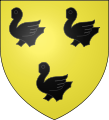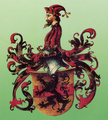Mutilated

Garbled is a technical term in heraldry and describes the appearance of a heraldic figure . A human figure or an animal figure are preferably emblazoned as mutilated if associated body parts are missing. The following parts may be missing from heraldic animals : teeth, beak, tongue, claws, feet or tail.
The mutilated eagle , also known as Alérion , and the merlette , the duck-like mutilated bird - sometimes also viewed as a mutilated blackbird , are special features .
The mutilation of a heraldic animal is very common in French heraldry . The lark or alouettes also belong to this group of French heraldry.
All possible body parts don't have to be missing at the same time. If a dog for example, ears and tail gestümmelt so is that as gestümmelt or desecrated emblazoned.
If human figures are mutilated, they are called dudes . Many human figures are growing in the coat of arms and are mutilated, often without arms. Example is the coat of arms of the Pappenheimer or the Mohrin in the upper coat of arms of the Haller von Hallerstein .
Also crosses may be gestümmelt. It is a cut off, a so-called shortened cross.
Branches in the coat of arms are also referred to as "mutilated". This frequently encountered description of the coat of arms is incorrect, because a “sawn-off” branch in the shield cannot be mutilated in the heraldic sense. In this regard, the simple question arises: What is the branch missing?
Examples (I)
Examples (II)
Oak stump with mutilated branches in Klötze's coat of arms
in silver a crooked red linden branch in the coat of arms of Harbke
literature
- Johann Simon Beckenstein: Kurtze introduction to the coat of arms art, and to the type of blazon. Imperial Academy of Sciences, St. Petersburg 1731, p.85 .n




